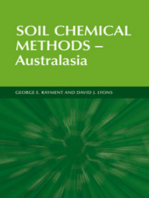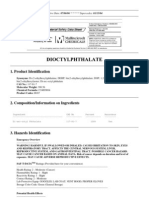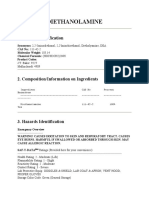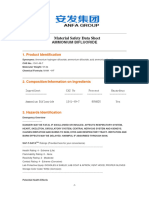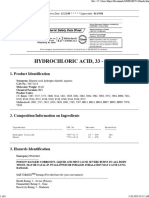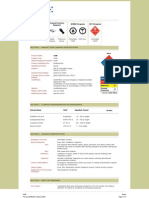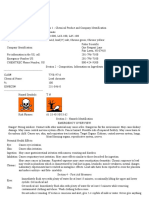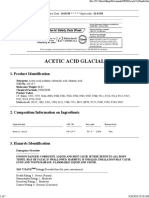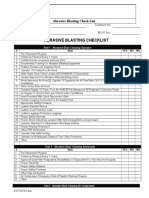MSDS Copper Metal
MSDS Copper Metal
Uploaded by
Claudia MmsCopyright:
Available Formats
MSDS Copper Metal
MSDS Copper Metal
Uploaded by
Claudia MmsOriginal Description:
Copyright
Available Formats
Share this document
Did you find this document useful?
Is this content inappropriate?
Copyright:
Available Formats
MSDS Copper Metal
MSDS Copper Metal
Uploaded by
Claudia MmsCopyright:
Available Formats
COPPER METAL
1. Product Identification
Synonyms: CAS No.: Molecular Weight: Chemical Formula: Product Codes: C.I. 77400; Arwood Copper 7440-50-8 63.546 Cu J.T. Baker: 1714, 1720, 1732, 1736 Mallinckrodt: 1733, 4649
2. Composition/Information on Ingredients
Ingredient ------------------------------Copper CAS No -----------7440-50-8 Percent ----------90 - 100% Hazardous --------Yes
3. Hazards Identification
Emergency Overview -------------------------------------------------------------------------------------------------------------------WARNING! HARMFUL IF SWALLOWED OR INHALED. CAUSES IRRITATION TO SKIN, EYES AND RESPIRATORY TRACT. AFFECTS THE LIVER AND KIDNEYS. CHRONIC EXPOSURE MAY CAUSE TISSUE DAMAGE. SAF-T-DATA(tm) Ratings (Provided here for your convenience) --------------------------------------------------------------------------------------------------------------------Health Rating: 3 - Severe (Life) Flammability Rating: 1 - Slight Reactivity Rating: 2 - Moderate Contact Rating: 1 - Slight Lab Protective Equip: GOGGLES & SHIELD; LAB COAT & APRON; VENT HOOD; PROPER GLOVES Storage Color Code: Green (General Storage) -----------------------------------------------------------------------------------------------------------------------1-
Potential Health Effects ---------------------------------Inhalation: Inhalation of dusts and fumes of metallic copper causes irritation of the upper respiratory tract, congestion of nasal mucous membranes, ulceration and perforation of the nasal septum, and pharyngeal congestion. Inhalation of copper fumes may give rise to metal fume fever (high temperature, metallic taste, nausea, coughing, general weakness, muscle aches, and exhaustion). Ingestion: Copper ingestion causes nausea, vomiting, abdominal pain, metallic taste, and diarrhea. Ingestion of large doses may cause stomach and intestine ulceration, jaundice, and kidney and liver damage. Skin Contact: Causes irritation to skin. Symptoms include redness, itching, and pain. Exposure to copper dust may cause a greenish-black skin discoloration. Eye Contact: Small copper particles in the eyes may cause irritation, discoloration, and damage. Chronic Exposure: Prolonged or repeated exposure to copper can discolor skin and hair and irritate the skin; may cause mild dermatitis, runny nose, and irritation of the mucous membranes. Repeated ingestion may damage the liver and kidneys. Repeated inhalation can cause chronic respiratory disease. Aggravation of Pre-existing Conditions: Persons with pre-existing skin disorders or impaired liver, kidney, or pulmonary function or pre-existing Wilson's disease may be more susceptible to the effects of this material.
4. First Aid Measures
Inhalation: Remove to fresh air. If not breathing, give artificial respiration. If breathing is difficult, give oxygen. Get medical attention. Ingestion: Induce vomiting immediately as directed by medical personnel. Never give anything by mouth to an unconscious person. Skin Contact: Immediately flush skin with plenty of soap and water for at least 15 minutes. Remove contaminated clothing and shoes. Get medical attention. Wash clothing before reuse. Thoroughly clean shoes before reuse. Eye Contact: Immediately flush eyes with plenty of water for at least 15 minutes, lifting lower and upper eyelids occasionally. Get medical attention immediately.
5. Fire Fighting Measures
Fire: Not considered to be a fire hazard since the bulk solid does not burn, but very finely divided particles (ultra-fine powder) may burn in air. Explosion: Not considered to be an explosion hazard. Reactions with incompatibles may pose an explosion hazard. Liquid copper explodes on contact with water. High concentrations of finely divided copper particles in the air may present an explosion hazard. Fire Extinguishing Media: Use any means suitable for extinguishing surrounding fire. Special Information: In the event of a fire, wear full protective clothing and NIOSH-approved self-contained breathing apparatus with full facepiece operated in the pressure demand or other positive pressure mode.
-2-
6. Accidental Release Measures
Ventilate area of leak or spill. Wear appropriate personal protective equipment as specified in Section 8. Spills: Sweep up and containerize for reclamation or disposal. Vacuuming or wet sweeping may be used to avoid dust dispersal. US Regulations (CERCLA) require reporting spills and releases to soil, water and air in excess of reportable quantities. The toll free number for the US Coast Guard National Response Center is (800) 424-8802.
7. Handling and Storage
Keep in a tightly closed container, stored in a cool, dry, ventilated area. Protect against physical damage. Avoid exposure to air and moisture. Isolate from incompatible substances. Containers of this material may be hazardous when empty since they retain product residues (dust, solids); observe all warnings and precautions listed for the product.
8. Exposure Controls/Personal Protection
Airborne Exposure Limits: Copper Dust and Mists, as Cu: - OSHA Permissible Exposure Limit (PEL) -1 mg/m3 (TWA) - ACGIH Threshold Limit Value (TLV) - 1 mg/m3 (TWA) Copper Fume: - OSHA Permissible Exposure Limit (PEL) -0.1 mg/m3 (TWA) - ACGIH Threshold Limit Value (TLV) 0.2 mg/m3 (TWA) Ventilation System: A system of local and/or general exhaust is recommended to keep employee exposures below the Airborne Exposure Limits. Local exhaust ventilation is generally preferred because it can control the emissions of the contaminant at its source, preventing dispersion of it into the general work area. Please refer to the ACGIH document, Industrial Ventilation, A Manual of Recommended Practices, most recent edition, for details. Personal Respirators (NIOSH Approved): If the exposure limit is exceeded and engineering controls are not feasible, a full facepiece particulate respirator (NIOSH type N100 filters) may be worn for up to 50 times the exposure limit or the maximum use concentration specified by the appropriate regulatory agency or respirator supplier, whichever is lowest. If oil particles (e.g. lubricants, cutting fluids. glycerine, etc.) are present, use a NIOSH type R or P filter. For emergencies or instances where the exposure levels are not known, use a full-facepiece positive-pressure, air-supplied respirator. WARNING: Air-purifying respirators do not protect workers in oxygen-deficient atmospheres. Skin Protection: Wear impervious protective clothing, including boots, gloves, lab coat, apron or coveralls, as appropriate, to prevent skin contact. Eye Protection: Use chemical safety goggles and/or full face shield where dusting or splashing of solutions is possible. Maintain eye wash fountain and quick-drench facilities in work area.
-3-
9. Physical and Chemical Properties
Appearance: Odor: Solubility: Density: pH: % Volatiles by volume @ 21C (70F): Boiling Point: Melting Point: Vapor Density (Air=1): Vapor Pressure (mm Hg): Evaporation Rate (BuAc=1): Reddish, metallic solid. Odorless. Insoluble in water. 8.94 No information found. 0 2595C (4703F) 1083C (1981F) Not applicable. 1 @ 1628C (2962F) No information found.
10. Stability and Reactivity
Stability: Stable under ordinary conditions of use and storage. Copper becomes dull when exposed to air; on exposure to moist air it gradually converts to the carbonate. On long standing, a white, highly explosive peroxide deposit may form. Hazardous Decomposition Products: No information found. Hazardous Polymerization: Will not occur. Incompatibilities: Copper is incompatible with oxidizers, alkalis, acetylene, chlorine plus oxygen difluoride, phosphorus, nitric acid, potassium peroxide, 1-bromo-2-propyne, sulfur plus chlorates. Reacts violently with ammonium nitrate, bromates, iodates, chlorates, ethylene oxide, hydrozoic acid, potassium oxide, dimethyl sulfoxide plus trichloroacetic acid, hydrogen peroxide, sodium peroxide, sodium azide, sulfuric acid, hydrogen sulfide plus air, and lead azide. A potentially explosive reaction occurs with actylenic compounds. Copper ignites on contact with chlorine, fluorine (above 121C), chlorine trifluoride, and hydrazinum nitrate (above 70C). An incandescent reaction occurs with potassium dioxide. Conditions to Avoid: Incompatibles and prolonged exposure to air and moisture.
11. Toxicological Information
No LD50/LC50 information found relating to normal routes of occupational exposure. Investigated as a tumorigen and a reproductive effector.
--------\Cancer Lists\----------------------------------------------------NTP Carcinogen--Ingredient Known Anticipated IARC Category -------------------------------------------------------Copper (7440-50-8) No No None
-4-
12. Ecological Information
Environmental Fate: Environmental Toxicity: No information found. No information found.
13. Disposal Considerations
Whatever cannot be saved for recovery or recycling should be managed in an appropriate and approved waste disposal facility. Processing, use or contamination of this product may change the waste management options. State and local disposal regulations may differ from federal disposal regulations. Dispose of container and unused contents in accordance with federal, state and local requirements.
14. Transport Information
Not regulated.
15. Regulatory Information
--------\Chemical Inventory Status - Part 1\---------------------------Ingredient ---------------------------------------Copper (7440-50-8) TSCA ---Yes EC --Yes Japan ----No Australia --------Yes
--------\Chemical Inventory Status - Part 2\-----------------------------Canada-Ingredient Korea DSL NDSL Phil. ----------------------------------------- ----- ------ ----Copper (7440-50-8) Yes Yes No Yes --------\Federal, State & International Regulations - Part 1\-----------SARA 302------SARA 313-----Ingredient RQ TPQ List Chemical Catg. ------------------------------------- ---------- -------------Copper (7440-50-8) No No Yes No --------\Federal, State & International Regulations - Part 2\-----------RCRA-TSCAIngredient CERCLA 261.33 8(d) ----------------------------------- ---------------Copper (7440-50-8) 5000 No No Chemical Weapons Convention: No TSCA 12(b): No SARA 311/312: Acute: Yes Chronic: Yes Fire: No Reactivity: No (Pure / Solid) CDTA: No Pressure: No
Australian Hazchem Code: None allocated. Poison Schedule: None allocated. WHMIS: This MSDS has been prepared according to the hazard criteria of the Controlled Products Regulations (CPR) and the MSDS contains all of the information required by the CPR.
-5-
16. Other Information
NFPA Ratings: Health: 2 Flammability: 0 Reactivity: 0 Label Hazard Warning: WARNING! HARMFUL IF SWALLOWED OR INHALED. CAUSES IRRITATION TO SKIN, EYES AND RESPIRATORY TRACT. AFFECTS THE LIVER AND KIDNEYS. CHRONIC EXPOSURE MAY CAUSE TISSUE DAMAGE. Label Precautions: Avoid contact with eyes, skin and clothing. Wash thoroughly after handling. Avoid breathing dust or vapors. Keep container closed. Use only with adequate ventilation. Label First Aid: If swallowed, induce vomiting immediately as directed by medical personnel. Never give anything by mouth to an unconscious person. If inhaled, remove to fresh air. If not breathing, give artificial respiration. If breathing is difficult, give oxygen. In case of contact, immediately flush eyes or skin with plenty of water for at least 15 minutes. Remove contaminated clothing and shoes. Wash clothing before reuse. In all cases, get medical attention. Product Use: Laboratory Reagent. Revision Information: MSDS Section(s) changed since last revision of document include: 3. Disclaimer: ********************************************************************************** Mallinckrodt Baker, Inc. provides the information contained herein in good faith but makes no representation as to its comprehensiveness or accuracy. This document is intended only as a guide to the appropriate precautionary handling of the material by a properly trained person using this product. Individuals receiving the information must exercise their independent judgment in determining its appropriateness for a particular purpose. MALLINCKRODT BAKER, INC. MAKES NO REPRESENTATIONS OR WARRANTIES, EITHER EXPRESS OR IMPLIED, INCLUDING WITHOUT LIMITATION ANY WARRANTIES OF MERCHANTABILITY, FITNESS FOR A PARTICULAR PURPOSE WITH RESPECT TO THE INFORMATION SET FORTH HEREIN OR THE PRODUCT TO WHICH THE INFORMATION REFERS. ACCORDINGLY, MALLINCKRODT BAKER, INC. WILL NOT BE RESPONSIBLE FOR DAMAGES RESULTING FROM USE OF OR RELIANCE UPON THIS INFORMATION. ********************************************************************************** Prepared by: Environmental Health & Safety Phone Number: (314) 654-1600 (U.S.A.)
-6-
You might also like
- Metrode WPS SuperduplexDocument4 pagesMetrode WPS SuperduplexClaudia Mms100% (3)
- Temper Bead Welding ProceduresDocument8 pagesTemper Bead Welding ProceduresClaudia Mms100% (2)
- MSDS SikloheksanolDocument11 pagesMSDS Sikloheksanolsupriyanto suhonoNo ratings yet
- Chemical Analysis Test Report: Element Sample T-1 Sample B-2 SAE/AISI Gr. A356.0Document2 pagesChemical Analysis Test Report: Element Sample T-1 Sample B-2 SAE/AISI Gr. A356.0Claudia MmsNo ratings yet
- Owen Barfield BibliographyDocument50 pagesOwen Barfield BibliographyClaudia MmsNo ratings yet
- WRC Bulletin No 506 Half-Bead Temper-BeadDocument2 pagesWRC Bulletin No 506 Half-Bead Temper-BeadClaudia MmsNo ratings yet
- Pre Spud InspectionDocument8 pagesPre Spud InspectionAgus Alexandri100% (3)
- Boone Circuit Court OrderDocument30 pagesBoone Circuit Court OrderChris98% (40)
- MSDS DopDocument5 pagesMSDS DopHenry WinsonNo ratings yet
- Mercury MSDS PDFDocument9 pagesMercury MSDS PDFNatalia PerelloNo ratings yet
- Page 1 of 5 Sodium Hypochlorite SolutionDocument5 pagesPage 1 of 5 Sodium Hypochlorite Solutionninju1No ratings yet
- Hno3 MSDSDocument9 pagesHno3 MSDSMashyem AhmedNo ratings yet
- Collodion, U. S. P.: 1. Product IdentificationDocument8 pagesCollodion, U. S. P.: 1. Product Identificationpearl ikebuakuNo ratings yet
- Cu SO4Document9 pagesCu SO4Bao Duy NguyenNo ratings yet
- Ammonia SolutionDocument7 pagesAmmonia SolutionpsshnkrNo ratings yet
- Nitric Acid 69-72%Document6 pagesNitric Acid 69-72%Hussain MarzooqNo ratings yet
- Nickel (II) Sulfate JTBakerDocument7 pagesNickel (II) Sulfate JTBakerGreace Io SimtoNo ratings yet
- MF7134 MSDSDocument5 pagesMF7134 MSDSDwi Yerlis RahmiNo ratings yet
- Diet Ha No Lam in 1Document7 pagesDiet Ha No Lam in 1Ardago LenggaNo ratings yet
- Ferric Ammonium SulfateDocument6 pagesFerric Ammonium SulfatemkgchemNo ratings yet
- Nh4oh MSDSDocument8 pagesNh4oh MSDSDavid SaguilNo ratings yet
- MSDS, Chromium Trioxide CrystalsDocument9 pagesMSDS, Chromium Trioxide CrystalsNikesh ShahNo ratings yet
- MSDS HCLDocument6 pagesMSDS HCLYuni Ayu LestariNo ratings yet
- Hydrocholoric AcidDocument4 pagesHydrocholoric AcidchapulincoloradoNo ratings yet
- Trikloretilen MSDSDocument8 pagesTrikloretilen MSDSserhat simsekNo ratings yet
- MSDS IpaDocument6 pagesMSDS IpaRizamuslim 13No ratings yet
- 1250 Red MSDSDocument4 pages1250 Red MSDSkwerwaNo ratings yet
- Plant Safety: 1. Product IdentificationDocument8 pagesPlant Safety: 1. Product IdentificationAditya SharmaNo ratings yet
- Petroleum Ether: 1. Product IdentificationDocument8 pagesPetroleum Ether: 1. Product IdentificationTrung HuynhNo ratings yet
- Xylenes: 1. Product IdentificationDocument9 pagesXylenes: 1. Product Identificationjesusruizbadra357No ratings yet
- Abf Msds AnfaDocument7 pagesAbf Msds AnfaalkanfilesalesNo ratings yet
- Perchloroethylene MSDSDocument7 pagesPerchloroethylene MSDSWeston DoucetteNo ratings yet
- Propanoic Acid JTBakerDocument7 pagesPropanoic Acid JTBakerkarthikeyanNo ratings yet
- CYCLOHEXANEDocument7 pagesCYCLOHEXANEEceNo ratings yet
- Sodium Hydroxide Solution: 1. Chemical Product and Company IdentificationDocument7 pagesSodium Hydroxide Solution: 1. Chemical Product and Company IdentificationTito Choirul HudaNo ratings yet
- Mercury: 1. Product IdentificationDocument4 pagesMercury: 1. Product IdentificationchapulincoloradoNo ratings yet
- Acetone MsdsDocument7 pagesAcetone MsdsManickNo ratings yet
- Cp1014 Sulfuric Acid MsdsDocument10 pagesCp1014 Sulfuric Acid MsdsPanneer SelvamNo ratings yet
- Mercury MSDSDocument11 pagesMercury MSDSLaron ClarkNo ratings yet
- Hydrochloric AcidDocument6 pagesHydrochloric AcidHussain MarzooqNo ratings yet
- Ferrous Sulphate - MSDSDocument6 pagesFerrous Sulphate - MSDSDyeing DyeingNo ratings yet
- Butyl AcetateDocument8 pagesButyl Acetatehaidar baqirNo ratings yet
- MSDS Phosphoric Acid 144-942Document3 pagesMSDS Phosphoric Acid 144-942Antonio CasNo ratings yet
- Ch3cooh MSDSDocument8 pagesCh3cooh MSDSAndre PNo ratings yet
- Hydrochloric Acid, 33 - 40%: 1. Product IdentificationDocument6 pagesHydrochloric Acid, 33 - 40%: 1. Product IdentificationdewiNo ratings yet
- H2so4 MSDSDocument6 pagesH2so4 MSDSMuhammad Aasim HassanNo ratings yet
- Oxalic Acid MsdsDocument5 pagesOxalic Acid MsdsAbdul QadeerNo ratings yet
- Material Safety Data Sheet: Section I - Product and Company IdentificationDocument5 pagesMaterial Safety Data Sheet: Section I - Product and Company Identificationmohdsuhail2k3055No ratings yet
- Safety H2so4Document8 pagesSafety H2so4vtpsNo ratings yet
- 186 Soldering Flux MSDSDocument5 pages186 Soldering Flux MSDSNicolae ChirilaNo ratings yet
- Potassium ChromateDocument5 pagesPotassium ChromateHussain MarzooqNo ratings yet
- Msds Timbal KromatDocument5 pagesMsds Timbal KromatWandaNo ratings yet
- Copper (II) Sulfate - Reagent - Anhydrous 98 - Acros OrganicsDocument5 pagesCopper (II) Sulfate - Reagent - Anhydrous 98 - Acros OrganicsGaryoNo ratings yet
- Material Safety Data SheetDocument13 pagesMaterial Safety Data SheetDhyta_Anne_Hudge_497No ratings yet
- Acetic Acid Glacial: 1. Product IdentificationDocument7 pagesAcetic Acid Glacial: 1. Product IdentificationAnonymous S3wsIptcONo ratings yet
- Jet A-1 W/o Anti-Icing Additive (FSII) : 1. Chemical & Company IdentificationDocument6 pagesJet A-1 W/o Anti-Icing Additive (FSII) : 1. Chemical & Company IdentificationsofelsbabaNo ratings yet
- Cadmium Sulfate 1% Cadmium Sulfate CrystalsDocument8 pagesCadmium Sulfate 1% Cadmium Sulfate CrystalsMussie WoldehawariatNo ratings yet
- Sodium Hypochlorite Solution: 1. Product IdentificationDocument6 pagesSodium Hypochlorite Solution: 1. Product IdentificationAnonymous fCNknAf8No ratings yet
- MSDS - Nitric AcidDocument5 pagesMSDS - Nitric AcidFkr JabarNo ratings yet
- MSDS Aldehid General: Toxicity DataDocument27 pagesMSDS Aldehid General: Toxicity DataHarliana Rahim100% (1)
- Sulfuric Acid, 52 - 100 %: 1. Product IdentificationDocument4 pagesSulfuric Acid, 52 - 100 %: 1. Product IdentificationchapulincoloradoNo ratings yet
- MSDS PMC Professional Metal CleanerDocument3 pagesMSDS PMC Professional Metal CleanerSterlingBankServicesNo ratings yet
- Acetone MSDS: Section 1: Chemical Product and Company IdentificationDocument7 pagesAcetone MSDS: Section 1: Chemical Product and Company IdentificationRanskuy YTNo ratings yet
- Ethyl AcetateDocument8 pagesEthyl Acetatevighnesh kumarNo ratings yet
- Msds Cyclohexanone: 1. Product IdentificationDocument9 pagesMsds Cyclohexanone: 1. Product IdentificationsuciNo ratings yet
- Alc-10030c Alcotec Alloy Selection BrochureDocument2 pagesAlc-10030c Alcotec Alloy Selection BrochurefogdartNo ratings yet
- Ways To Avoid Boiler Tube CorrosionDocument8 pagesWays To Avoid Boiler Tube CorrosionTiu TonNo ratings yet
- Titanium Spec - Chart PDFDocument1 pageTitanium Spec - Chart PDFClaudia MmsNo ratings yet
- Advantages and Limitations of Martensitic Steels For FusionDocument4 pagesAdvantages and Limitations of Martensitic Steels For FusionClaudia MmsNo ratings yet
- What Is Bellows Pressure Thrust PDFDocument2 pagesWhat Is Bellows Pressure Thrust PDFClaudia MmsNo ratings yet
- How To Become Certified by ASME 2010Document2 pagesHow To Become Certified by ASME 2010quiron2010No ratings yet
- DPVC 09 PetrobrasDocument47 pagesDPVC 09 PetrobrasClaudia MmsNo ratings yet
- An Introduction To Cathodic Protection PDFDocument5 pagesAn Introduction To Cathodic Protection PDFGERMAN1979No ratings yet
- Expansion of The Sourcebook For Hydrogen Applications 03-10-2006Document1 pageExpansion of The Sourcebook For Hydrogen Applications 03-10-2006Claudia MmsNo ratings yet
- Inspection and Welding Repairs of Pressure VesselsDocument9 pagesInspection and Welding Repairs of Pressure VesselsClaudia Mms100% (1)
- In Situ Repair Welding of Steam Turbine ShroudDocument7 pagesIn Situ Repair Welding of Steam Turbine ShroudClaudia Mms100% (1)
- Condition of The Firetube Right After Removal From ServiceDocument1 pageCondition of The Firetube Right After Removal From ServiceClaudia MmsNo ratings yet
- Welding of Stainless Steels and Other Joining Methods: A Designers' Handbook Series N 9 002Document18 pagesWelding of Stainless Steels and Other Joining Methods: A Designers' Handbook Series N 9 002Sreenivas Guduru100% (1)
- EPRI Repair & Replacement Apps Center - Socket Weld Repair Issues 1013562Document20 pagesEPRI Repair & Replacement Apps Center - Socket Weld Repair Issues 1013562Claudia Mms100% (1)
- FCAW Temper Bead Iamot - OrgDocument7 pagesFCAW Temper Bead Iamot - OrgClaudia MmsNo ratings yet
- Solidification Cracking in SS Welds Pe1119Document24 pagesSolidification Cracking in SS Welds Pe1119Claudia Mms100% (1)
- Pickling HandbookDocument20 pagesPickling HandbookRhona100% (1)
- Nitrocellulose Hazardous SubstanceDocument6 pagesNitrocellulose Hazardous SubstanceoviangNo ratings yet
- Msds PDFDocument6 pagesMsds PDFYuNa YoshinoyaNo ratings yet
- Buffer Solution Borate) PH 10 PDFDocument7 pagesBuffer Solution Borate) PH 10 PDFCheng Khie ChiehNo ratings yet
- W18ke00-Workshop Manual PDFDocument549 pagesW18ke00-Workshop Manual PDFRavinder SinghNo ratings yet
- Chemical Name Class: Non-Flammable Gas MixtureDocument6 pagesChemical Name Class: Non-Flammable Gas MixtureKaro toorNo ratings yet
- Ops Core SOTR Operators ManualDocument20 pagesOps Core SOTR Operators ManualȘtefan BulgaruNo ratings yet
- Hardware & DIYDocument447 pagesHardware & DIYMoitshephi Samuel100% (2)
- Nitrobenzene MSDSDocument5 pagesNitrobenzene MSDSscribd405No ratings yet
- Abrasive Blasting Check ListDocument3 pagesAbrasive Blasting Check ListSreejith Suresh100% (1)
- Meguiar's M08 - Mirror Glaze Maximum Mold Release Wax (23-135A)Document21 pagesMeguiar's M08 - Mirror Glaze Maximum Mold Release Wax (23-135A)jeanada phillipsNo ratings yet
- Miller Dialarc 250 Ac-DcDocument28 pagesMiller Dialarc 250 Ac-Dcdavid caraoNo ratings yet
- Module 2Document129 pagesModule 2Vimal SankarNo ratings yet
- Fehling ADocument5 pagesFehling AronaNo ratings yet
- Safety Data Sheet: SECTION 1: Identification of The Substance/mixture and of The Company/undertakingDocument11 pagesSafety Data Sheet: SECTION 1: Identification of The Substance/mixture and of The Company/undertakingsriatul2006No ratings yet
- MSDS of AceticacidDocument9 pagesMSDS of AceticacidNazmul hasanNo ratings yet
- 81000-82000 SeriesDocument47 pages81000-82000 SeriesHenryGaltNo ratings yet
- Revision: 01 Date: 16.05.2017: Material Safety Data SheetDocument8 pagesRevision: 01 Date: 16.05.2017: Material Safety Data SheetSaninNo ratings yet
- Commander 750 875 1200 ManualDocument80 pagesCommander 750 875 1200 ManualCoco BangoNo ratings yet
- Galmet Iroize - GalmetDocument4 pagesGalmet Iroize - GalmetBiju_PottayilNo ratings yet
- Material Safety Data Sheet Firebond: Ingredients Material Cas Reg. No. % Acgih (TLV) PELDocument2 pagesMaterial Safety Data Sheet Firebond: Ingredients Material Cas Reg. No. % Acgih (TLV) PELMounir BoutaghaneNo ratings yet
- MSDS - Europe - 907 - 02 - en - 30315 - UK HbsAg UltraDocument15 pagesMSDS - Europe - 907 - 02 - en - 30315 - UK HbsAg UltraJermain BarbadosNo ratings yet
- AEC Air Eraser Parts ListDocument2 pagesAEC Air Eraser Parts Listspaced_boyNo ratings yet
- MNO2Document6 pagesMNO2Raditya Rizki AmaliaNo ratings yet
- Seriola-1510 MSDS v181205Document12 pagesSeriola-1510 MSDS v181205waqasasad408No ratings yet
- (Full List) INDIAN STRANDED CODE OF PERSONAL PROTECTIVE EQUIPMENT PPE - RLS HUMAN CARE PDFDocument7 pages(Full List) INDIAN STRANDED CODE OF PERSONAL PROTECTIVE EQUIPMENT PPE - RLS HUMAN CARE PDFHarshal VaidyaNo ratings yet
- Nickel Metal MSDS: Section 1: Chemical Product and Company IdentificationDocument6 pagesNickel Metal MSDS: Section 1: Chemical Product and Company IdentificationJagiyanti ShergeivichNo ratings yet
- MSDS Silica Sand MaterialSafetyDataSheetDocument12 pagesMSDS Silica Sand MaterialSafetyDataSheetOziel RomeroNo ratings yet
- Smaw 8 Module 3 - V5Document23 pagesSmaw 8 Module 3 - V5Mary Antoinette MagallanesNo ratings yet
